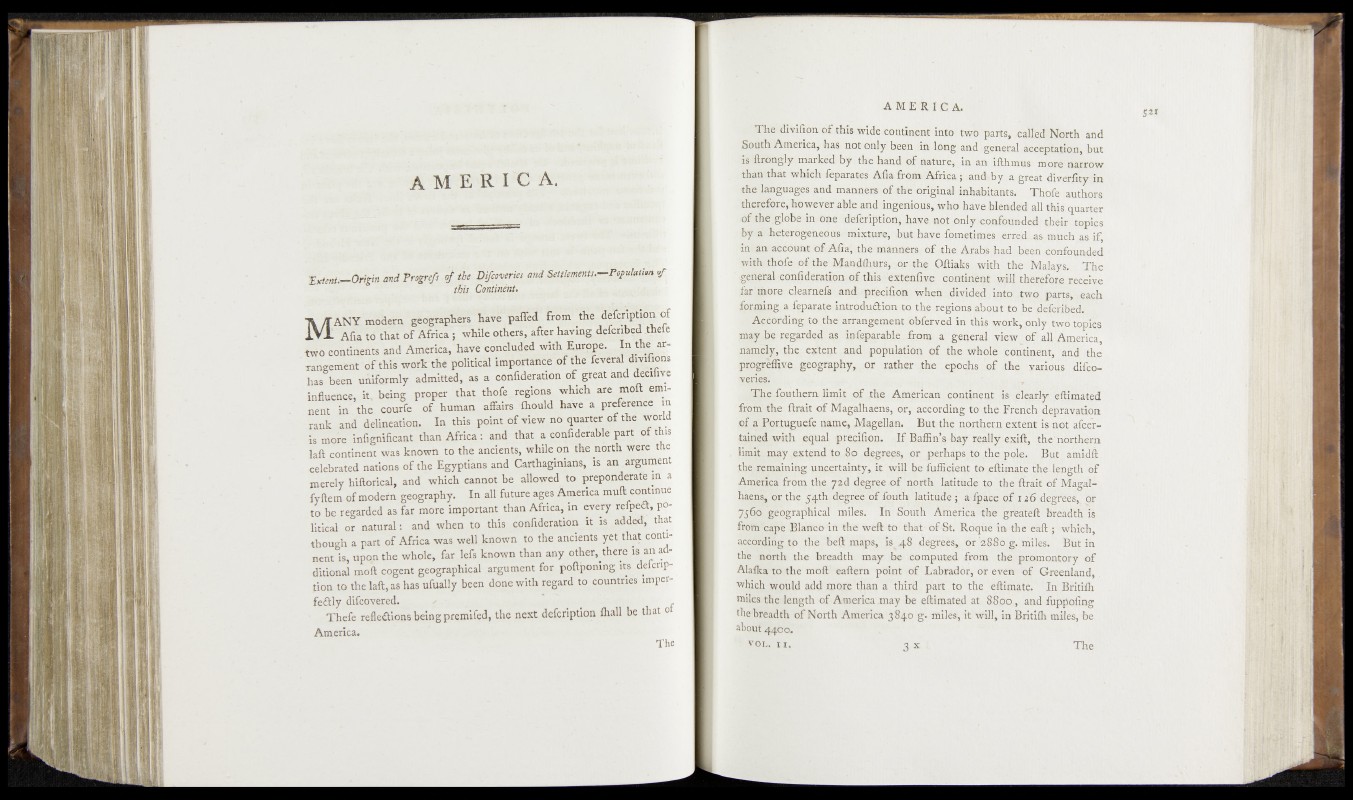
A M E R I C A.
Sxttnl^-Origin and Tregrefs •/' the Di/cn
this Continent.
MANY modem geographers have paffed from the heferipttorL of
Afia to that of Africa; while others, after having described thefe
two continents and America,'have concluded with Europe% In the arrangement
o f this work the political importance of ftle feveraldrvlfions
has been uniformly admitted, as a confutation of great and debihve
influence, it, being proper that thofe. regions which are moft eminent
in.the courfe of human affairs-fhonld have a. presence in
rank and delineation. In this point of view no quarter of the,-world
1 more infignificaut than Africa: and that part this
laft continent was known to the ancients, while on the north were Pie
celebrated nations of the Egyptians and Carthaginians, is an^raument
merely hiftorical, and which cannot he allowed to preponderate ftf a
fyftem of modern geography. In all future ages America mpft continue
to be regarded as far more important than Africa, in every refpeagpo-
litical or natural: and when to this confideration it is added', Jhat
though a part of Africa was well known to the ancients yet that continent
is, upon the whole, far lefs known than any other, .there is an additional
moft cogent geographical argument for poftpomng its deJcrip-
tion to the laft, as has ufually been done with regard to countries imperfectly
difcovered. t - > r
Thefe reflections being premifed, the next defcription ftiall be that o
The
The cfivifion o f this^wdekonrin.ent into two parts, called ’North and
SouthfA$®?ka, «has not oiily hegp, m long andlggueral acceptation,
is fftró'nglycmarkédihy. tb&hamd ^n a tu re, in an ifthmpy more-narrow
thaarthat wMch feparafes, A?fia from. A f r i c a a , gfeat diverjSty in
the languages and manaei^^ofithlp^^ihibiiahabiföpts,. .Thofe authors
therefore, however,able ania^ggqiops, whtf^fvgj^ei^^fall this,quarter
by'a ihèterögeiieous' mix-tM®, «but bai^pasjfl^Afes. s, if,
i® anuaeeount of Asfla* the manners,, A#at*vfiad beem ,corfcftir^ed
with thofe ®sf||he jthf Qftiak^ Th4
" general cOnfi deration, of this I eict^fi.vcêlfontfnem: ™I1 receive
f tr ^ o r e , dearriefs an^preclfipp,, whjen divided, in to two parts,'.each
forcing a feparatefi^j(rpd^qn„ta tbg pjjtajt ddfclifed*/«
y^cording to the;arrangement;lËÏl^r|;.éd in't^k w o rk ^ oS tw o topics
may he regarded as iofeparable from a general vie w^pf? aft ^America,
namely, the extent and population of the continet, and 4fte
prpgjreflive geography, or rather the • epochs ,!k|. the xa&Uf ’$%>-
ve,rie.s.
The .fputhern limit of ,the American continent ris- eleariy eftiinated
from the ftrait of Magalhaens, of,, .according-to the feeA^'dyBjavatrdn
.plj a Portuguefe name, Magellan. B.ut-the northern ex|ept,is not" afeer-
tained with equal presififtn, If Baffin’s bay really',exift, the ^n orthern
limit may extend "to $o ..degrees* or; ni^haps J , But, amid ft
the remaining uncertainty, it |wi]I be fufficient to .eftipaate the lengtli of
America from the J2d degree -p£ 'north latitude tp'thg.ftrai.t of lvfagal-
haens, or the Cftth degree óf fouth jatitude ; aTpace of i i'ó^qègreel^ of
7'r6& geographical mileS, IfrV'SoTOh' mneneaS^^ grhatèft' bfeadthTs
frolft^eape Blan'cO in the Weft to that- of>St. Roque in the eaft ; which,
according to the beft maps, is 48 degrees, ór dflSmift&t But in
thé north the breadth may be computed from the, promontory of
Alafka to the mofteaftern po-int of Labrador, dr evetP of'1 Greenland,
which would add roo.r.e than a third part to thé eftiüiate. In Britifh
uiilesi the length of America may be eftimated at $ w o a and fuppofing
the'bfeadfh of North Athefica 3840 g* hSllés, it vrill, in Britifh miles, be
abpuf 4400.
VOL. I I . 3 x The